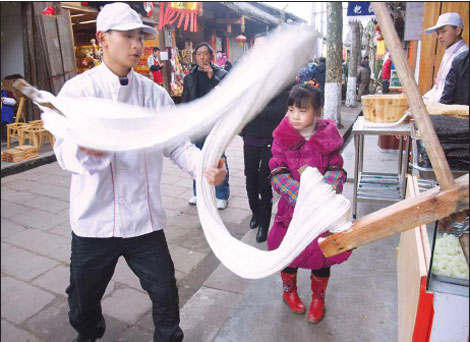Life
Inertia can be delicious
By Chitralekha Basu (China Daily)
Updated: 2011-01-13 08:09
 |
Large Medium Small |
|
A sugar store assistant tries to attract attention by twisting and kneading a lump of sugar. Chen Liang / China Daily |
The "ancient city" of Pingle, as it is often called, is 90 km west of downtown Chengdu, Sichuan province, but does not appear to be that ancient if you're inside the funky Music Memories bar, in the city square, on the southern bank of the Baimo River.
But that's the charm of Pingle, there's the present and there's plenty to back its claim of antiquity. Founded sometime around 150 BC, Pingle has retained the impressions of the several eras it has lived through.
Strolling down Qilong Street, for instance, you can drop by an old-style smithy. The jovial owner, who claims this is a 300-year-old family business, will demonstrate how to work up a big fire in the hearth by pumping the bellows. He might even allow you to have a go at hammering the pieces of smoldering soft iron on the anvil, if he is in the mood.
Not too far away is a maiden cheerfully twisting and kneading a lump of lily-white sugar roughly the size of her own diminutive figure, to get an even consistency. The final product, she insists, helps one get rid of a stubborn cold.
Across the river, on the north bank, is the sprawling Tiangong Yingwu Garden and house, which belonged to a patrician in the 1930s. The thresholds leading to the unroofed inner courtyard are unusually high, an indicator of his high rank. Inside, past the bright red drapes adorning the doorframes are quaint frog-mouth-shaped containers to hold and filter rainwater.
The farm space has a printing press, calligraphy center and a brewery (now defunct, but the equipment is preserved for the sake of historicity). An unused red satin-draped sedan stands on the edge of what used to be an expansive, circular performance/meeting space, waiting for the warmth of human touch.
Further north is Lugou bamboo forest. It's easy to get bogged down by the never-ending groves of reeds that seem to reach for the skies, looking down on the thin stream, cutting and meandering through the rocky terrain.
One pedestrian bridge across the river is just a series of unevenly sawed wooden planks, each suspended by a pair of rather flimsy-looking ropes. If you have ever wondered what it's like on a flying trapeze, this could be your chance to check it out.
A little deeper into the forest - or bamboo sea, as it is aptly called, what with the towering reeds reflected in the water beneath, creating an intense fluid canvas - lies a paper-making mill from the Song Dynasty (960-1279).
The elaborate contraption has not been used for a long time, as evidenced by the thick patina of moss. But it's not difficult to see how the mechanism worked, propelled by power generated by the water mill. Huge vats, in which the bamboo would have been shredded and beaten to a pulp, have been lying empty for ages.
Pingle life is somewhat laid-back but Xinxing street, running almost horizontally across the town, is immensely colorful.
A shallow canal, less than two meters wide, runs right through its middle, punctuated by quaint bridges with intricate carvings on them. A primitive husking stone attached to a rotating lever, rests under a pagoda roof. A giant water wheel, nestling among the weeds, leads to a pool bordered by lavenders, peonies and bluebells.
The street's southern half is a celebration of food. Small mountains of tofu - balls, cubes and slices, coated in a range of nerve-numbing red, orange and yellow ochre sauces - are heaped in steel basins, selling at 8 yuan ($1.21) a jar (500 grams).
Sesame-coated candies and patties, which also come in an incredible variety of flavors and shapes, are a favored snack as they stay fresh and crisp all year round.
Roasted chunks of meat hang from hooks at shop fronts, like frilly decorations. A decent eight-course meal for four people, complete with one's chosen fish netted from the giant aquariums and fried or curried instantly, with a mandatory overdose of red hot chili pepper, costs around 140 yuan.
There's lots more one could do in Pingle with a little more time on one's hands, such as hiking to nearby Jinhua, Huaqiu and Qilong hills, for example. Legend has it that wishes made on the Jinhua summit are usually fulfilled.
Alternatively, one could take a stroll down South Silk Road Culture Garden, to learn about the trade route that connected China with the Mediterranean in the late 19th century and walk the stretch that passed through Pingle before veering off toward Kashgar in the northwest.
Or visit the oldest tea garden in the area and the Li family courtyard next to it. The latter is a typically affluent civilian household from the Qing Dynasty (1644-1911) era, with pronounced Sichuanese characteristics. Artistic types could try their hand at weaving strands of bamboo over porcelain.
Shopaholics hunting for souvenirs can find anything from ornate silver Miao headgear to cheerful straw figures in the stores and kiosks surrounding the octagonal pavilion.
Or one could just sit beside Leshan bridge, held together by a series of pillars merging with one another to form Gothic arches, and watch the world sail by in a pagoda-roofed bamboo raft, along the Baimo River.
Give in to the languorous pace and understated the charm of Pingle. Inertia can be delicious.
